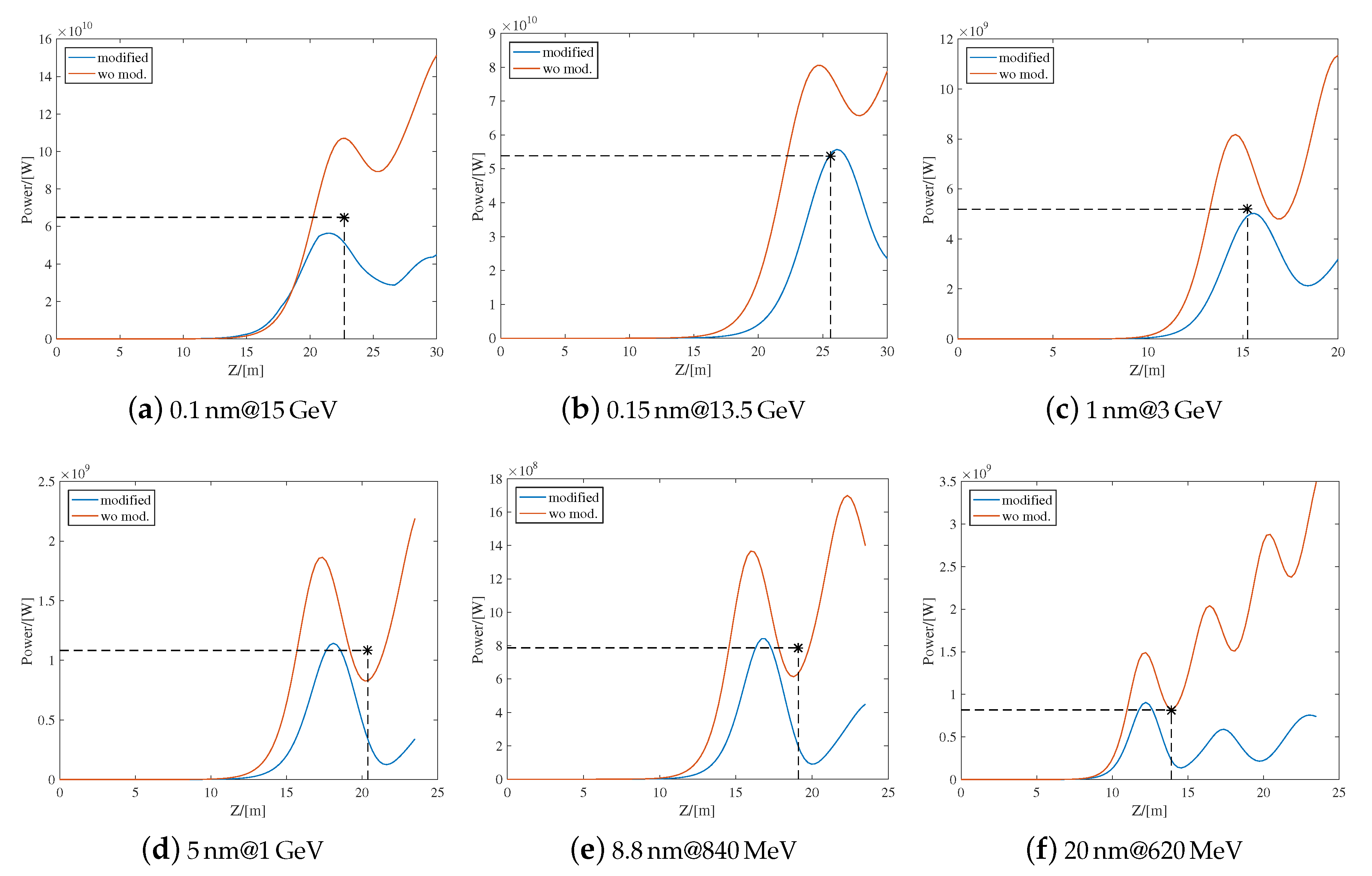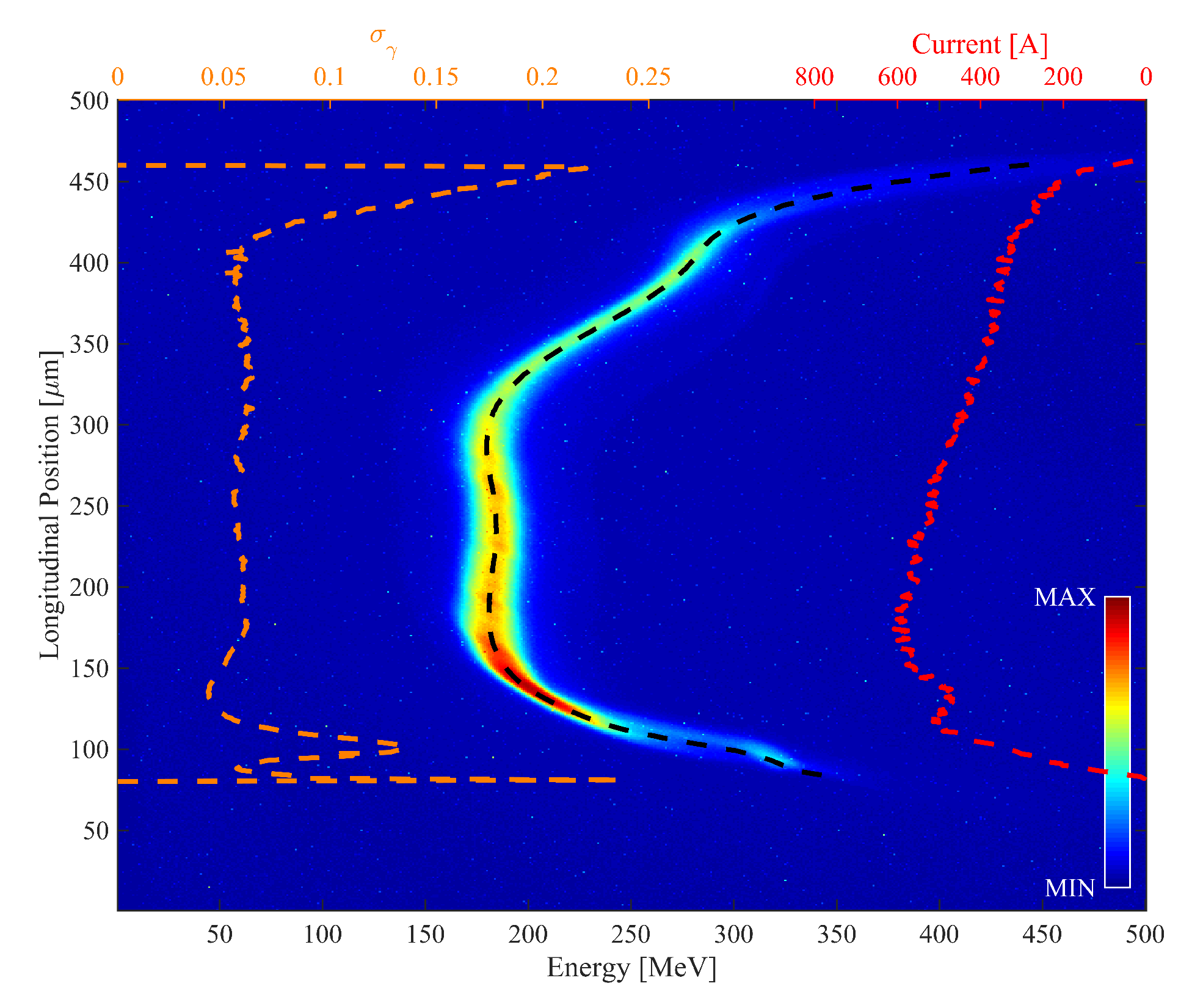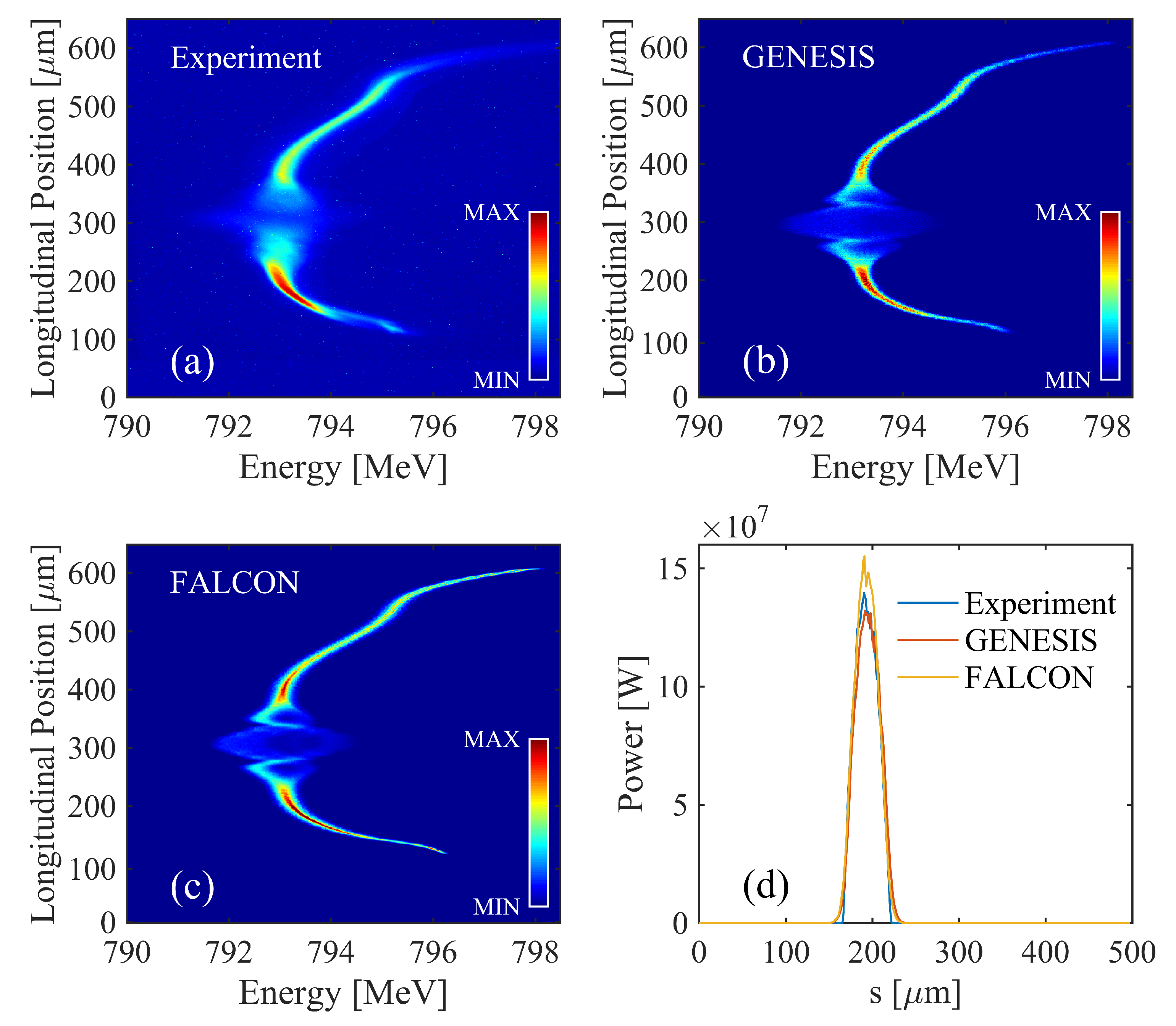A Super-Fast Free-Electron Laser Simulation Code for Online Optimization
Abstract
1. Introduction
2. Methods and Mathematical Model
2.1. The Initial Particle Generation from Shot-Noise
2.2. The FODO Lattice and Undulator Tapering
2.3. Modulator and Dispersion Section
2.3.1. Fast Sinusoidal Modulation
2.3.2. Single-Particle Tracking Modulation
2.4. Radiation Diffraction
2.5. The Working Equations
2.6. Validation
3. Results and Discussion
3.1. Example Simulations
3.2. Implementation at SXFEL
4. Conclusions
Author Contributions
Funding
Acknowledgments
Conflicts of Interest
References
- Young, L.; Kanter, E.P.; Krässig, B.; Li, Y.; March, A.M.; Pratt, S.T.; Santra, R.; Southworth, S.H.; Rohringer, N.; DiMauro, L.F.; et al. Femtosecond electronic response of atoms to ultra-intense X-rays. Nature 2010, 466, 56–61. [Google Scholar] [CrossRef] [PubMed]
- Öström, H.; Öberg, H.; Xin, H.; Larue, J.; Beye, M.; Dell’Angela, M.; Gladh, J.; Ng, M.L.; Sellberg, J.; Kaya, S.; et al. Probing the transition state region in catalytic CO oxidation on Ru. Science 2015, 347, 978–982. [Google Scholar] [CrossRef] [PubMed]
- Kang, Y.; Zhou, X.E.; Gao, X.; He, Y.; Liu, W.; Ishchenko, A.; Barty, A.; White, T.A.; Yefanov, O.; Han, G.W.; et al. Crystal structure of rhodopsin bound to arrestin by femtosecond X-ray laser. Nature 2015, 523, 561–567. [Google Scholar] [CrossRef] [PubMed]
- Reiche, S. GENESIS 1.3: A fully 3D time-dependent FEL simulation code. Nucl. Instrum. Methods A 1999, 429, 243–248. [Google Scholar] [CrossRef]
- Fawley, W.M. An Informal Manual for GINGER and its post-processor XPLOTGIN. CBP Tech Note-104 1995, LBID-2141, UC-414. [Google Scholar]
- Saldin, E.; Schneidmiller, E.; Yurkov, M. FAST: A three-dimensional time-dependent FEL simulation code. Nucl. Instrum. Methods A 1999, 429, 233–237. [Google Scholar] [CrossRef]
- Dejus, R.J.; Shevchenko, O.A.; Vinokurov, N.A. An integral equation based computer code for high-gain free-electron lasers. Nucl. Instrum. Methods A 1999, 429, 225–228. [Google Scholar] [CrossRef][Green Version]
- Tanaka, T. SIMPLEX: Simulator and postprocessor for free-electron laser experiments. J. Synchrotron Radiat. 2015, 22, 1319–1326. [Google Scholar] [CrossRef]
- Freund, H.P.; van der Slot, P.J.M.; Grimminck, D.L.A.G.; Setija, I.D.; Falgari, P. Three-dimensional, time-dependent simulation of free-electron lasers with planar, helical, and elliptical undulators. New J. Phys. 2017, 19, 023020. [Google Scholar] [CrossRef]
- Campbell, L.T.; McNeil, B.W.J. Puffin: A three dimensional, unaveraged free electron laser simulation code. Phys. Plasmas 2012, 19, 093119. [Google Scholar] [CrossRef]
- Biedron, S.; Chae, Y.; Dejus, R.; Faatz, B.; Freund, H.; Milton, S.; Nuhn, H.D.; Reiche, S. Multi-dimensional free-electron laser simulation codes: A comparison study. Nucl. Instrum. Methods A 2000, 445, 110–115. [Google Scholar] [CrossRef][Green Version]
- Biedron, S.; Chae, Y.C.; Dejus, R.; Faatz, B.; Freund, H.; Milton, S.; Nuhn, H.D.; Reiche, S. The APS SASE FEL: Modeling and code comparison. In Proceedings of the PAC99, New York, NY, USA, 27 March–2 April 1999; pp. 2486–2488. [Google Scholar]
- Campbell, L.; Freund, H.; Henderson, J.; McNeil, B.; Traczykowski, P.; van der Slot, P. Comparison Between, and Validation Against an Experiment of, a Slowly-Varying Envelope Approximation Code and a Particle-in-Cell Simulation Code for Free-Electron Lasers. In Proceedings of the FEL19, Hamburg, Germany, 26–30 August 2019; pp. 153–156. [Google Scholar]
- Zeng, L.; Feng, C.; Gu, D.; Li, J.; Zhao, Z. The beam-based alignment for soft X-ray free-electron lasers via genetic algorithm. Nucl. Instrum. Methods A 2018, 905, 104–111. [Google Scholar] [CrossRef]
- Jiao, Y.; Wu, J.; Cai, Y.; Chao, A.W.; Fawley, W.M.; Frisch, J.; Huang, Z.; Nuhn, H.D.; Pellegrini, C.; Reiche, S. Modeling and multidimensional optimization of a tapered free electron laser. Phys. Rev. ST Accel. Beams 2012, 15, 050704. [Google Scholar] [CrossRef]
- Emma, C. UCLA PBPL. Available online: http://pbpl.physics.ucla.edu/Computing/Code_Development/Perave (accessed on 15 October 2019).
- Giannessi, L. Simulation codes for high brightness electron beam free-electron laser experiments. Phys. Rev. ST Accel. Beams 2003, 6, 114802. [Google Scholar] [CrossRef]
- Bajlekov, S.I.; Hooker, S.M.; Bartolini, R. Simulating sub-wavelength temporal effects in a seeded FEL driven by laser-accelerated electrons. In Proceedings of the FEL2009, Liverpool, UK, 23–28 August 2009; pp. 119–122. [Google Scholar]
- McNeil, B.W.J.; Robb, G.R.M. Self-amplified coherent spontaneous emission in the planar wiggler free-electron laser. Phys. Rev. E 2002, 65, 046503. [Google Scholar] [CrossRef]
- McNeil, B.W.J.; Robb, G.R.M.; Poole, M.W. An improved 1-D model for ultra high power radiation pulse propagating in the helical wiggle free-electron laser. In Proceedings of the PAC03, Portland, OR, USA, 12–16 May 2003; pp. 953–955. [Google Scholar]
- Hammersley, J.M.; Handscomb, D.C. Monte Carlo Methods, 1st ed.; Springer: Dordrecht, The Netherlands, 1964. [Google Scholar]
- Box, G.E.P.; Muller, M.E. A Note on the Generation of Random Normal Deviates. Ann. Math. Stat. 1958, 29, 610. [Google Scholar] [CrossRef]
- Penman, C.; McNeil, B. Simulation of input electron noise in the free-electron laser. Opt. Commun. 1992, 90, 82. [Google Scholar] [CrossRef]
- Reiche, S. Numerical Studies for a Single Pass High Gain Free-Electron Laser. Ph.D. Thesis, University Hamburg, Hamburg, Germany, 1999. [Google Scholar]
- Fawley, W.M. Algorithm for loading shot noise microbunching in multidimensional, free-electron laser simulation codes. Phys. Rev. ST Accel. Beams 2002, 5, 070701. [Google Scholar] [CrossRef]
- Kim, K.J.; Huang, Z.; Lindberg, R. Synchrotron Radiation and Free-Electron Lasers: Principles and Coherent X-ray Generation, 1st ed.; Cambridge University Press: Cambridge, UK, 2017. [Google Scholar]
- Stupakov, G. Using the Beam-Echo Effect for Generation of Short-Wavelength Radiation. Phys. Rev. Lett. 2009, 102, 074801. [Google Scholar] [CrossRef]
- Wang, X.; Feng, C.; Tsai, C.Y.; Zeng, L.; Zhao, Z. Obliquely incident laser and electron beam interaction in an undulartor. Phys. Rev. Accel. Beams 2019, 22, 070701. [Google Scholar] [CrossRef]
- Xie, M. Exact and variational solutions of 3D eigenmodes in high gain FELs. Nucl. Instrum. Methods A 2000, 445, 59–66. [Google Scholar] [CrossRef]
- Huang, Z.; Kim, K.J. Review of X-ray free-electron laser theory. Phys. Rev. ST Accel. Beams 2007, 10, 034801. [Google Scholar] [CrossRef]
- Zhao, Z.; Wang, D.; Gu, Q.; Yin, L.; Gu, M.; Leng, Y.; Liu, B. Status of the SXFEL Facility. Appl. Sci. 2017, 7, 607. [Google Scholar] [CrossRef]
- Ding, Y.; Behrens, C.; Emma, P.; Frisch, J.; Huang, Z.; Loos, H.; Krejcik, P.; Wang, M.H. Femtosecond X-ray Pulse Temporal Characterization in Free-Electron Lasers Using a Transverse Deflector. Phys. Rev. ST Accel. Beams 2011, 14, 120701. [Google Scholar] [CrossRef]
- Behrens, C.; Decker, F.J.; Ding, Y.; Dolgashev, V.A.; Frisch, J.; Huang, Z.; Krejcik, P.; Loos, H.; Lutman, A.; Maxwell, T.J.; et al. Few-femtosecond time-resolved measurements of X-ray free-electron lasers. Nat. Commun. 2014, 5, 3762. [Google Scholar] [CrossRef]
- Plath, T.; Lechner, C.; Miltchev, V.; Amstutz, P.; Ekanayake, N.; Lazzarino, L.; Maltezopoulos, T.; Bödewadt, J.; Laarmann, T.; Roßbach, J. Mapping few-femtosecond slices of ultra-relativistic electron bunches. Sci. Rep. 2017, 7, 2431. [Google Scholar] [CrossRef]






| Parameters | Value | Unit |
|---|---|---|
| Beam energy | 15 | GeV |
| Normalized emittance | 0.3 | mm mrad |
| Relative energy spread | – | |
| Peak current | 4000 | A |
| FEL wavelength | 0.1 | nm |
| Normalised undulator parameter | 2.178 | – |
| Undulator period | 3 | cm |
| Parameters | Value | Unit |
|---|---|---|
| Beam energy | 840 | MeV |
| Slice energy spread | 50 | keV |
| Normalized emittance | 1.5 | mm mrad |
| Peak current | 800 | A |
| Wavelength of seed laser | 265 | nm |
| Energy modulation amplitudes(A1/A2) | 4/2 | – |
| Dimensionless dispersion strength(B1/B2) | 16.35/0.56 | – |
| Normalised undulator parameter | 1.012 | – |
| Undulator period | 23.5 | cm |
| FEL wavelength | 8.8 | nm |
Publisher’s Note: MDPI stays neutral with regard to jurisdictional claims in published maps and institutional affiliations. |
© 2020 by the authors. Licensee MDPI, Basel, Switzerland. This article is an open access article distributed under the terms and conditions of the Creative Commons Attribution (CC BY) license (http://creativecommons.org/licenses/by/4.0/).
Share and Cite
Zeng, L.; Feng, C.; Wang, X.; Zhang, K.; Qi, Z.; Zhao, Z. A Super-Fast Free-Electron Laser Simulation Code for Online Optimization. Photonics 2020, 7, 117. https://doi.org/10.3390/photonics7040117
Zeng L, Feng C, Wang X, Zhang K, Qi Z, Zhao Z. A Super-Fast Free-Electron Laser Simulation Code for Online Optimization. Photonics. 2020; 7(4):117. https://doi.org/10.3390/photonics7040117
Chicago/Turabian StyleZeng, Li, Chao Feng, Xiaofan Wang, Kaiqing Zhang, Zheng Qi, and Zhentang Zhao. 2020. "A Super-Fast Free-Electron Laser Simulation Code for Online Optimization" Photonics 7, no. 4: 117. https://doi.org/10.3390/photonics7040117
APA StyleZeng, L., Feng, C., Wang, X., Zhang, K., Qi, Z., & Zhao, Z. (2020). A Super-Fast Free-Electron Laser Simulation Code for Online Optimization. Photonics, 7(4), 117. https://doi.org/10.3390/photonics7040117





